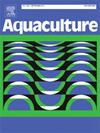Validation of gut transit rate assessment methodology and the mitigation of sampling stress in Atlantic salmon, Salmo salar
IF 3.9
1区 农林科学
Q1 FISHERIES
引用次数: 0
Abstract
Gut transit rate is an important component of the digestive process in fish, particularly in the context of aquaculture, where factors such as rearing temperature and dietary formulation impact on-farm performance. As such, developing and validating research methodologies that explore these critical physiological responses in fish is vital in the context of precision aquaculture practices. However, there are inherent methodological constraints of gut transit rate assessments, particularly when assessing the effect of sampling on the stress response of fish. In light of this, the present study aimed to assess the gut transit rate and plasma cortisol levels of Atlantic salmon (Salmo salar) subjected to the more commonly applied, repeated sampling model that results in multiple tanks disturbances (e.g., 2, 4, 8, 16 and 24 h post-feed) in comparison to one requiring only a singular tank disturbance at one of the designated time points. An inert beaded marker was integrated into diet formulations to determine the transit rate of digesta in three major gastrointestinal tract regions: the stomach, mid-intestine, and distal intestine over a period of 48 h following the provision of food. A significantly higher plasma cortisol concentration was recorded in fish subjected to a repeated disturbance, particularly at 16 h post feed (22.99 ± 6.88 ng mL−1), compared to fish sampled from tanks subjected to a single sampling event (11.35 ± 0.92 ng mL−1). Despite this, gut transit rate was generally unaffected by sampling design over the duration of the study with both groups of fish displaying a similar rate of gut transit. This suggests that repeated tank sampling (i.e. sampling multiple fish from the same tank at multiple timepoints) is suitable to assess gut transit rate in fish as it does not significantly confound gut transit rate assessments. It is envisioned that this data will contribute to the growing understanding of the digestive process of Atlantic salmon and the relationship with stress response in fish and experimental design. Moreover, it should strengthen future studies aimed at assessing key digestive processes in cultured species.
验证肠道通过率评估方法和减轻大西洋鲑采样压力
肠道转运率是鱼类消化过程的重要组成部分,尤其是在水产养殖中,饲养温度和日粮配方等因素都会影响养殖绩效。因此,在精准水产养殖实践中,开发和验证探索鱼类这些关键生理反应的研究方法至关重要。然而,肠道转运率评估存在固有的方法限制,尤其是在评估取样对鱼类应激反应的影响时。有鉴于此,本研究旨在评估大西洋鲑鱼(Salmo salar)的肠道转运率和血浆皮质醇水平,与只需要在一个指定时间点对水槽进行单次干扰的模式相比,前者采用了更常用的重复采样模式,导致水槽受到多次干扰(如投喂后 2、4、8、16 和 24 小时)。在日粮配方中加入惰性珠状标记物,以测定提供食物后 48 小时内消化物在胃部、中肠道和远端肠道这三个主要胃肠道区域的转运率。与单次采样(11.35 ± 0.92 ng mL-1)相比,多次受到干扰的鱼类血浆皮质醇浓度明显较高,尤其是在投喂食物后 16 小时(22.99 ± 6.88 ng mL-1)。尽管如此,在整个研究期间,两组鱼的肠道转运率基本不受取样设计的影响,表现出相似的肠道转运率。这表明,重复水槽取样(即在多个时间点对同一水槽中的多条鱼进行取样)适用于评估鱼类的肠道转运率,因为它不会对肠道转运率评估产生重大影响。预计这些数据将有助于进一步了解大西洋鲑的消化过程以及与鱼类应激反应和实验设计之间的关系。此外,它还能加强今后旨在评估养殖物种关键消化过程的研究。
本文章由计算机程序翻译,如有差异,请以英文原文为准。
求助全文
约1分钟内获得全文
求助全文
来源期刊

Aquaculture
农林科学-海洋与淡水生物学
CiteScore
8.60
自引率
17.80%
发文量
1246
审稿时长
56 days
期刊介绍:
Aquaculture is an international journal for the exploration, improvement and management of all freshwater and marine food resources. It publishes novel and innovative research of world-wide interest on farming of aquatic organisms, which includes finfish, mollusks, crustaceans and aquatic plants for human consumption. Research on ornamentals is not a focus of the Journal. Aquaculture only publishes papers with a clear relevance to improving aquaculture practices or a potential application.
 求助内容:
求助内容: 应助结果提醒方式:
应助结果提醒方式:


